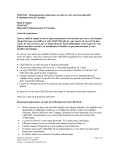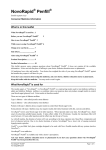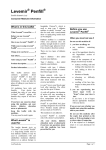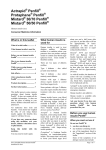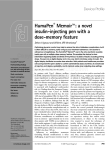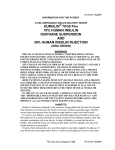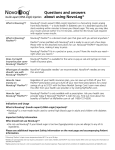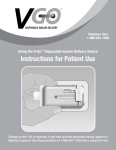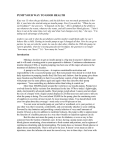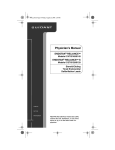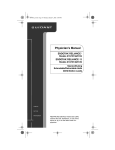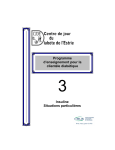Download Drawing Up and Giving Insulin
Transcript
TOPICS: Chapter 9 Drawing Up and Giving Insulin Medications: Insulin Mixing and Administration TEACHING OBJECTIVES: 1. Demonstrate technique for mixing and drawing up insulin. 2. Identify age appropriate injection sites. 3. Instruct injection technique. 4. Observe family members/self giving insulin injection. H. Peter Chase, MD Catherine Suffoletta, RN WHERE TO INJECT THE INSULIN Insulin is injected into the fat layer beneath the skin. Proper techniques must be learned so that the insulin is not injected too close to the outer skin (which may cause a lump, pain or a red spot) or too deep into the muscle (which may cause pain and insulin to be absorbed too quickly). If the injections are given in the recommended areas (see diagram of the Pink Panther), it is very unlikely that a large artery or vein will be entered. The only problem if this were ever to happen would be that the insulin would last only a matter of minutes rather than hours. Also, it is not true that injecting a bubble of air into someone (even into an artery or vein) would harm them. These are common, but unnecessary worries. LEARNING OBJECTIVES: Learners (parents, child, relative or self) will be able to: 1. Complete accurate demonstration for mixing and drawing up insulin. 2. Choose two age appropriate sites for injections. 3. Demonstrate correct injection technique using saline. 4. Demonstrate correct injection technique using insulin. INJECTION SITES The best places to give insulin (in order) are the: • buttocks (seat): slowest absorbing • abdomen (holding pinch of fat): fastest absorbing • arms (holding a pinch of fat) • thighs (holding a pinch of fat) These are the sites with the most subcutaneous fat (listed in order). Rotation of injection sites used to be a frequent area of 77 conflict between parents and children. It is now possible to select two or three of the usual four areas for injections and to skip areas that are not well tolerated. Injections should be moved around within the sites that are used (example: six to nine areas in each buttock site). If there are swollen or lumpy (hypertrophied) areas, injections should not be given into these sites, as the insulin may be absorbed at a different rate causing high blood sugars. Insulin is absorbed more rapidly from the abdomen than from the arm, and more rapidly from the arm than from the thigh or buttock. However, the differences are not great for most people. The buttock should generally be used for injections of Lantus insulin to make certain it is given into the fatty tissue. You may also use an area where a large pinch of fat can be held. Based on recent studies done in Sweden, it is considered necessary to take a pinch of the skin even when using the short needle. The exceptions may be the buttock area or the central abdomen if there is a sufficient amount of fat tissue. INSULIN SYRINGES (See picture diagram of insulin syringes and Table 1) There are now several brands of disposable insulin syringes with varying needle widths (measured in gauges with a larger number for a thinner needle) and varying lengths. The needles are thin and are sharp for easy insertion. If money is short, the syringes can be reused. If you are using a mixed insulin such as NPH, it is not suggested to reuse your needles as this can cause contamination to your rapid acting insulin. If you must reuse your needle, push the plunger up and down several times to remove as much of the old insulin as possible from the needle. Then store needles in the refrigerator to prevent growth of bacteria. The needle may be dulled as a result of going through the rubber stopper on the insulin vial more than one time. If dulled, then it might cause more tissue damage. There is also the possibility of infection when reusing syringes. There is some increase in uptake of rapidacting insulin when the shot is given in an area that is then exercised. Injecting into an arm or leg which will be used in an activity may result in low blood sugars during exercise, due to the increased blood flow to the area being exercised. Therefore, if you are to play tennis, don’t inject into the arm that will be used to swing the racquet. A low blood sugar could occur. 10 20 15 30 20 40 25 50 30 units 3/10cc units 1/2cc Chapter 9 – Drawing Up and Giving Insulin units 78 1cc Insulin should also not be injected just prior to a bath, shower or hot tub. The warm water will draw more blood to the skin, causing a rapid absorption and resulting in a serious low blood sugar. If the water is warm enough to turn your skin pink then the insulin will be absorbed more quickly. Wait at least 90 minutes after giving rapid acting insulin to get into hot water. 10 20 30 40 50 60 70 80 90 100 5 10 Insulin Syringes 1 2 39 40 35 41 6 4 36 42 5 3 7 37 8 38 43 44 49 45 46 51 47 48 53 9 10 11 12 13 14 50 15 16 17 18 19 20 52 54 21 28 22 23 24 25 29 30 31 32 26 27 33 34 Injection Rotation Chart Chapter 9 – Drawing Up and Giving Insulin 79 The amount of insulin the syringe will hold varies. There are 3/10cc and 1/2cc syringes for people using less than 30 or 50 units of insulin per injection, or 1cc syringes for those using more than 50 units per injection (see drawings). The B-D Ultra-Fine II short needles are just 5/16 inch (8mm) in length (compared with the usual 1/2 inch [12.7mm] length) and at 30 gauge are very thin. There are also 3/10cc syringes with 1/2 unit markings allowing for smaller doses of insulin to be measured. This syringe can be helpful for young children. DRAWING UP THE INSULIN You will be shown how to draw the insulin into the syringe. YOU SHOULD LEARN BY PRACTICE AND FORM GOOD HABITS FROM THE START. When possible, wash your hands first. The picture diagrams show how to draw up insulin and give an injection. Our families often start by doing “air” shots into a doll or mannequin. The next practice step is drawing up sterile salt water (saline) and doing the injection into each other. This helps family members to realize how little the pain is from the shots. In addition, Table 1 gives a checklist to follow. The nurse will go over the checklist with you at regular intervals. These are the steps: Get everything together: alcohol, insulin and a syringe. Wash your hands. Push the plunger of the disposable syringe up and down before drawing in the insulin. This will help soften the rubber at the end of the plunger and smooth the plunger action. Wipe the top of the insulin bottle(s) with alcohol and allow to air dry. Insert the needle through the rubber top of the bottle of rapid-acting (Humalog/NovoLog/Apidra) or Regular insulin with the bottle sitting upright on the 80 Chapter 9 – Drawing Up and Giving Insulin table. Turn the bottle (with the needle inserted) upside down. To remove any air bubbles, draw out about five more units of insulin than needed and push quickly back into the bottle. This can be repeated several times as needed until air bubbles are cleared. “Flicking” the syringe barrel with the finger is not recommended as it can cause the needle to bend. After the air bubbles are gone, adjust the top edge of the rubber plunger to be in line with the exact number of units needed. The needle can then be removed from the vial and held or the cap put on the needle. Some families leave the needle in the rapid-acting insulin bottle until the NPH insulin is mixed. Others hold the syringe in one hand while mixing the NPH insulin (turning up and down 20 times) with the other hand. NEVER lay the syringe down on the table with the needle exposed as this may lead to bacteria collecting on the needle and cause an infection. If also receiving an intermediate-acting insulin (NPH) or long-lasting insulin (Lantus) it can be drawn into the same syringe at this time. The mixing of Lantus insulin with a rapid-acting insulin is not yet approved by the FDA and should be done only with the permission of your doctor or nurse. Our experience is that five to 10 percent of families feel their child does better when the rapid-acting insulin and Lantus are given separately. Prepare the NPH insulin by turning the bottle back and forth to mix. Do not vigorously shake the NPH insulin as this may break it down and cause the insulin to absorb differently. Some people roll the bottle between the palms of their hands. The NPH bottle should be turned or rolled gently 20 times to mix thoroughly. Avoid touching the rubber stopper of the vial if it has already been wiped with alcohol. Clear insulins (e.g., Lantus) do not need to be mixed. However, the mixture will turn cloudy as the Lantus is drawing into the syringe containing the rapid-acting insulin. This does not seem to matter. into the bottle and push in the air within the syringe. Remove the needle from the bottle. Remove the cap from the syringe containing the rapid-acting insulin. Insert the needle into the bottle of the NPH (or Lantus) insulin while the bottle is upside down. This prevents air from the vial getting into the syringe. With the bottle turned upside down, slowly draw the number of units of the NPH (or Lantus) insulin needed. The total number of units in the syringe will be the sum of the rapid-acting units plus the NPH (or Lantus) units. After mixing the two types of insulin, never reinject insulin from the syringe back into the intermediate insulin bottle. This will give you an incorrect dose of insulin. If you draw up too much insulin you will need to throw your syringe away and draw up your dose again. Draw air into the syringe again, the amount equal to the dose of the rapid-acting insulin. With the rapid-acting bottle upright on a table, insert the needle and push in the air. Leave the needle in the bottle and turn upside down. Follow the steps outlined above to withdraw the insulin doses required. Venting the insulin bottles: In the past, we instructed families to inject air into the insulin bottles with each dose. This was to prevent a vacuum from developing, which would pull the insulin drawn out, back into the bottle. In recent years, most of our families have preferred to “vent” their insulin bottles once a week. This is done by using a new syringe and removing the plunger from the syringe barrel. With the insulin vial sitting upright on the table, insert the needle into the rubber stopper and allow air to equalize in the insulin bottle. This will remove any vacuum, which may be inside the bottle. This will only take a moment. Pick one consistent day of the week to vent the bottles. Some families may prefer to inject the air when drawing up the insulin. This is particularly true when large doses are being given. The amount of air injected into a bottle equals the number of units of insulin being withdrawn. The air should be added to the intermediate-acting insulin bottle first. The rubber stopper of the bottle should first be cleaned with alcohol. With the bottle sitting upright, insert the needle The people who make insulin recommend changing insulin vials every 30 days if the bottle is kept at room temperature. This is due to the possible growth of bacteria. Blood sugars should be watched carefully when the insulin bottle is almost empty. If the blood sugars start to be unusually high or low, the last bit of insulin should be discarded. Some people prefer to just routinely discard the insulin when it only fills the neck of the turned bottle. The expiration date on the bottle should always be checked and the insulin discarded if that date is reached. Unopened, refrigerated insulin is good until the manufacturer’s expiration date on the top of the box. In summary, BE PRECISE ABOUT THE DOSAGE. An overdose can cause an insulin reaction or low blood sugar. If you ever take an incorrect dose, be sure to notify your diabetes care provider. It is wise to have the morning and afternoon dosages posted on the refrigerator or some obvious place to prevent confusion. Children below age 10 do not usually have the fine motor abilities and concern for accuracy to draw up insulin by themselves. Parents should assist them with these tasks (see Chapter 18). Chapter 9 – Drawing Up and Giving Insulin 81 Table 1 Drawing Up Insulin A. Gather supplies: Insulin, syringe, alcohol wipe for tops of bottles, log book with current tests and insulin dosage (please record each blood sugar result in log book after each test). Do not confuse the rapid-acting insulin vial with the Lantus vial (both are clear). B. Technique: Know correct insulin dosage Wipe tops of insulin bottles with alcohol swab Either “vent”* the bottles weekly (smaller doses) or put air into the long-acting (cloudy) insulin with the bottle upright and remove the needle. Put air in the clear insulin and leave the needle in. Draw up clear (rapid-acting) insulin, get rid of air bubbles and remove the needle Mix the cloudy NPH insulin vial by gently turning the bottle up and down 20 times; this ensures that the insulin gets well mixed Slowly draw up the NPH (or Lantus) insulin into the syringe, making sure not to push any insulin already in the syringe back into the vial. For people now mixing Lantus insulin with a rapid-acting insulin, the clear Lantus insulin will become cloudy as it is pulled into the syringe holding the rapid-acting insulin. This does not usually cause problems with needle-plugging. If insulin vials have been in the refrigerator, you can warm up the insulin once it is mixed in the syringe by holding the syringe in the closed palm of your hand for 1-2 minutes; it will be less likely to sting if brought to room temperature Give insulin injection * An option now used by some people is to not put air into the bottles, but to just “vent” the bottles to remove any vacuum once weekly (see text). 82 Chapter 9 – Drawing Up and Giving Insulin HOW TO INJECT THE INSULIN (See Table 2 and picture diagrams) Clean the site of injection with soap and water (or an alcohol swab or hand sanitizer if camping or in a hospital). Alcohol dries and toughens the skin and is not routinely recommended. Lift the skin and fat tissue between the thumb and the first finger. If you are using the B-D ULTRA-FINE II (0.3, 0.5 or 1.0cc) syringe with short needles (5/16 inch) and the fat in the area of injection is adequate, the needle can be inserted at a 90º angle (usually only the buttock or seat area on younger children). In other areas, where there is not as much fat, a “gentle pinch” should still be used during the injection. Touch the needle to the skin, holding the syringe at a 90º angle (or less). It is generally best to push the needle all the way into the skin. If the needle is not in far enough, the insulin may not be injected into the fatty layer. If it goes into the layer directly under the skin rather than into the fatty layer, it will sting and may cause a bump or redness and itching. To insure injection into fat, the “gentle pinch” can continue to be held during the injection of the insulin. Inject the insulin by pushing the plunger down with a SLOW and steady push as far as it will go. Some people like to wait a few seconds to let the insulin “spread out” after each five units of insulin is injected. A smooth injection is important. AFTER THE INSULIN IS IN, WAIT FIVE TO TEN SECONDS BEFORE REMOVING THE NEEDLE. COUNT SLOWLY TO FIVE. THIS WILL HELP TO PREVENT INSULIN LEAKAGE FROM THE INJECTION SITE. A loss of one drop of insulin may be equal to two to five units. Loss of insulin is a common reason for variations in the blood sugar levels. If “leak-back” continues to be a problem Table 2 Giving the Insulin Choose injection site; use a good site rotation plan Make sure the site is clean. You may use alcohol if needed. Relax the chosen area. Deep slow breathing may help with this. Lift up the skin with a “gentle pinch” Touch the needle to the skin and gently push it through the skin. Use a 45° angle for the 1/2 inch or 5/8 inch long needle or a 90° angle is ok for the 5/16 inch (short) needle when giving the injection into the buttocks. If there is not much fat, a “gentle pinch” should still be used even with the short needles. To insure injection into fat, the “gentle pinch” can continue to be held during the injection Push the insulin in slowly and steadily Wait five to 10 seconds to let the insulin spread out Put a finger or dry cotton over the site after the needle is pulled out. Gently rub a few seconds to close the track. Put pressure on the site. If bruising or bleeding are common, you may need to consider using areas with more fat tissue for injections. Observe for a drop of insulin (“leakback”); note in record book if a drop of insulin is present Chapter 9 – Drawing Up and Giving Insulin 83 soapy SOAP A. Wash hands B. Warm and mix insulin D. Pull out dose of insulin F. Pinch up skin and fat tissue if using 5/8 inch needle. Go straight in if using the 5/16 inch (short) needle. 84 Chapter 9 – Drawing Up and Giving Insulin C. Wipe top of insulin bottle with alcohol E. Make sure injection site is clean G. Inject insulin at 45° (5/8 inch) or 90° (5/16 inch needle) move to a new site. Also, two units of air can be drawn into the syringe after removing the needle from the insulin bottle. Then flick the side of the syringe with a finger to make the air rise up under the plunger. The air will then be injected after the insulin and will help to prevent “leak-back.” begin to work in 10 minutes, and food is converted to blood sugar in 10 minutes, so it is best to get some insulin in prior to the meal when this is possible. An exception is with the toddler or a picky eater who has variable food intake, when it may be better to wait to give the shot until after seeing how much food has been eaten (see Chapter 17). After the injection, place a finger or dry cotton swab over the site of injection. Hold for a few seconds to prevent any bleeding. Gently rub the site to close the needle track. Some bleeding may occur after the needle is pulled out; this is not harmful, although some insulin may be carried out with the blood. Press the dry cotton firmly on the site. Some people put their finger over the site where the needle came out and rub gently. The finger should be clean. (If you are getting pain or bleeding often with shots, you may be depositing the insulin into muscle. You should consider using a different site with more fat tissue.) With Regular insulin, it is best to take the shot 30 to 60 minutes before eating. This allows the Regular insulin to start working at the time food is eaten. It will prevent the blood sugar from going very high in the half-hour or hour after eating. When the pre-meal blood sugar level is known, the time can be varied between the shot and eating the meal, as shown in Table 3. It has been our experience that using a time scale such as this can improve blood sugar control. The plastic syringes are recommended for one time use only by the manufacturer. The needle becomes dull after one use and may be more painful by the second or third shot. If they are to be reused, after giving the injection, push the plunger up and down to get rid of any insulin left in the needle. Wipe the needle off with an alcohol swab. Put the cap over the needle and store the syringe and needle in the refrigerator until ready for the next use. Table 2 provides a summary for injecting the insulin. WHEN TO INJECT THE INSULIN Most people now routinely use Humalog/ NovoLog/Apidra (rapid-acting) insulins and they must eat soon after taking their shot. When the blood sugar is high (e.g., > 200 mg/dl [> 11.1 mmol/L] it may be wise to wait 10 minutes after the injection to begin eating (Table 3). The rapid-acting insulin analogs Regular and NPH insulins can be premixed and are even sold in bottles of premixed combinations. If insulin is mixed in a syringe prior to giving the shot (premixed), it will be necessary to roll the syringe between the hands to mix it thoroughly. It is best to give these types of insulin within five minutes of drawing up to avoid the insulin “sticking to the sides of the syringe.” DISPOSING OF NEEDLES It is never recommended to throw any needles or lancets into the trash; someone may get poked and this can spread very harmful germs, such as HIV or Hepatitis B. It is recommended to dispose of sharps into a red biohazard container. An alternative is to place needles into a very thick plastic container such as a bleach bottle or laundry detergent bottle. Once the bottle is full you may recap it tightly and then tape the cap with strong tape such as duct tape to assure the bottle will not open. This can then be put out with your trash. The BD company provides a Safe-Clip® device to clip and store needles. This is a convenient device for traveling. This device holds approximately 1,500 needles, which is about one year’s worth of needles. Chapter 9 – Drawing Up and Giving Insulin 85 (for no other reason) after the bottle has been open for 30 days or more, throw away the bottle. STORAGE Ideally, insulin should be stored in the refrigerator and warmed to room temperature prior to giving the shot. Most people keep the bottles they are using at room temperature (except in a very hot climate). It will not be as likely to sting or to cause red spots after injection if it is kept at room temperature. After drawing up insulin that has been in the refrigerator, the filled, capped syringe can also be warmed in the closed palm of your hand to avoid stinging. A drawer in the kitchen might be identified for storage of all diabetes supplies. Research has shown that if insulin is stored at room temperature, it loses 1.5 percent of its potency per month (after one month 1cc U100 insulin would have 98.5 units of insulin rather than 100 units). For most people, this small change would not make a difference (9.85 units rather than 10.0 units). One of the insulin manufacturers wrote: “Insulin vials currently in use may be kept at room temperature for 30 days, in a cool place and away from sunlight.” Insulin will spoil if it gets above 90º or if it freezes. Insulin bottles (or pens) should not be exposed to extreme temperature changes, such as being left in a car in the hot summer or the cold winter. If NPH insulin has spoiled, sometimes clumps will then be seen sticking to the sides of the insulin bottle. That bottle and the accompanying bottle of rapid-acting insulin should not be used if this occurs. Unfortunately, the rapid-acting (clear) insulins have only subtle changes and may look cloudy or even slightly yellow. If this is the case the insulin should be thrown away immediately and replaced with new bottles. It may have bacteria (germs) growing in it. We have also suggested throwing away bottles of insulin that have been opened for six weeks or more, even if refrigerated. Families using low dosages of a particular insulin may find it more effective to draw out of 300 unit insulin pen cartridges (for Humalog/NovoLog, Regular, Lantus or NPH insulins). If blood sugars rise 86 Chapter 9 – Drawing Up and Giving Insulin INSULIN PENS Use of insulin pens has increased greatly in recent years. This is related to people wanting an easy method to take supplements of rapidacting insulins with food intake during the day. For all pens, the giving of the shot is similar to the giving of a shot with a syringe (Table 2). The same general directions should be followed. The needle must have the paper tab removed and then be screwed onto the pen. This insulin is already present in the pen and does not have to be drawn from a vial. Also, rather then drawing back a plunger in a syringe to determine the insulin dose, the number of units of insulin to be given are dialed in for a pen. With all pens, a two unit “priming-dose” should be entered, the needle pointed upward and the button pushed. This takes care of any “dead-space” without insulin in the needle. Make sure that you see a steady stream of insulin with the priming dose to assure you will receive your total dose of insulin. The desired insulin dose to be given can then be dialed in and given. It is important to slowly count for five to 10 seconds before removing the needle from the skin or you may not receive your full dose of insulin. Using a pen results in increased convenience for the person. In addition, people are more apt to cover the food they are eating with insulin, particularly when away from home. Pens can be divided into two groups. First are those that are pre-filled disposable pens that are discarded after using. Second are permanent pens that hold cartridges of insulin. The cartridge is replaced in the pen after the insulin is used up (or after one month). A. Disposable Pens Lilly Pre-filled Disposable Pens: Lilly disposable pens for Humalog, Humulin NPH, 70/30 NPH/Regular and Humalog Mix 75/25 insulins all hold 3 ml (300 units) and are readily available. The pens are simple to use and will take a small B-D 31 gauge (5/16 inch) Ultra-Fine III® needle or a NovoFine® 30 gauge (1/3 inch) disposable needle. With the Lilly pens the dose knob must be turned until the arrow lines up under the tiny magnifying glass. The plunger is then pulled back and the dose dialed in. NovoLog Flex Pen®: The Novo Nordisk pre-filled disposable pen holds 3 ml (300 units) of NovoLog insulin. NovoFine 30 or 31 gauge needles are used with the pen. The instructions are very similar to the above and are included in the box and on the website (www.novonordiskus.com or www.novologflexpen.com) or talk to your nurse educator. With any pre-filled insulin pen, gently rub the injection site with the finger once or twice after the needle is removed. This helps to close the track from the needle and reduce “leak-back.” Some care providers do not recommend reuse of pen needles as the needle may become dull and cause tissue damage at the injection site. B. Cartridge Pens The Sanofi-Aventis Company recently made Lantus insulin available in 3 ml cartridges which fit into the OptiClick® (Insulin Delivery Device). Use of this pen will help prevent mix-ups with the clear rapid-acting insulins. More information can be obtained at www.opticlik.com or talk to your nurse educator. The NovoPen® 3.0 from Novo Nordisk and the B-D pen offer the use of cartridges of Regular, NPH, 70/30 NPH/Regular or Humalog/NovoLog insulins. The cartridges contain 3.0 ml of insulin (300 units) and are replaced into the pen when the cartridge is empty. The NovoPen 3.0 delivers a dose of two to 70 units. The B-D pen has a maximum dose of 30 units. A colorful pen from Novo Nordisk is called the Novopen-Junior® that can deliver 1/2 unit doses. The minimum dose that can be delivered is 1 unit. It takes the 3 ml insulin cartridges so it can be used with any Novo Nordisk 3.0 insulin cartridge available. The directions for the NovoPen 3.0 are, once again, fairly simple: 1. Remove the cap (the part with the pocket clip) and unscrew the silver bottom to drop the cartridge of insulin down into the holder (metal cap first). Make sure the piston rod is flat (even) at the end of the top of the plunger. Then screw the silver bottom back on tightly. 2. Wipe the rubber stopper with alcohol, remove the paper tab from the needle and screw the needle on the end of the pen (until tight). 3. Turn the dial to one or two units. Pull off both needle caps and, holding the needle upward, push the button on the end to see if insulin comes out. If not, repeat the procedure until insulin appears (to get rid of all air). Do this with each usage of the pen. 4. For giving the shot, starting at “0,” turn the dial-a-dose selector to the required dose, lift up the skin (as directed earlier) and insert the needle (assuming adequate fat). Press the button on the end down firmly to deliver all insulin. Wait five to 10 seconds, pull the needle out and rub gently. Place the small plastic cover over the needle and put the cap with the pocket clip back on the pen. The Innovo® pen from Novo Nordisk has special features. It takes 3 ml (cc) NovoLog cartridges from the Novo Nordisk company only. It requires a standard pen needle which screws on to the end of the cartridge. A user manual and Quick Guide comes with the Innovo. These give very clear directions, so they won’t be repeated here. Two of the features are: 1. It tells when your last shot was given and how much was taken. The clock is divided into four quarters. There are three dots within each quarter. Each dot represents one hour. The dose of the last injection appears below the clock. 2. As the plunger is pressed, segments of a circle appear. These segments gradually meet forming a complete circle. This closed Chapter 9 – Drawing Up and Giving Insulin 87 circle indicates the entire dose has been given. In the past, families have been concerned that if a drop was left on the needle, the full dose was not given. This should no longer be a concern. The InDuo™ is a pen/meter combination from Novo Nordisk. The Innovo pen is combined with the Ultra meter. Some people will appreciate having both a meter and an insulin pen in one device. Visit the following web site address: www.induo.com for more information or ask your nurse educator. C. Pen Needles Becton, Dickinson and Company (BD) now has three pen needles on the market. They are: Name Length (inches) Width (mm) BD Original 1/2 12.7 BD Short 5/16 8 BD Mini 3/16 5 The BD Mini was introduced in 2002. The BD Mini can be used with pens made by BD, Lilly and NovoNordisk. INJECTION AIDES The Insuflon is made by Unomedical and is a 17mm plastic cannula very similar to the insertion tube for the insulin pump. However, instead of connecting to a pump, the end is covered and has a port for giving insulin injections. It can be left under the skin for up to five days (remove sooner if redness develops). EMLA® cream can be applied 30-60 minutes before insertion to diminish pain. All insulins, including Humalog, NovoLog, Apidra, NPH and Lantus may be given through the port. The best place for insertion is the buttocks, followed by the central abdomen. The skin must be pinched if other sites are used. IV Prep™ (Skin Prep™) can be used to help hold the Insuflon in place. The Insuflon is particularly helpful for people with needle fear and for young children receiving multiple daily injections. School aides will sometimes give injections into the Insuflon even though they will not inject insulin into the skin. Glucagon can also be given through the Insuflon. The pharmacy of one of our families obtains the Insuflon devices through Amerisource Bergen (1-800-523-4020, item #4509725). It can also be ordered from National Diabetic Pharmacies at 1-800-467-8546 and then hit 8965 or 8964. Table 3 Pre-Meal Blood Sugar and Time to Wait Before Eating Blood Sugar Level mmol/L mg/dl Time to Wait Before Eating (Minutes) Type of Insulin Humalog/NovoLog/Apidra Regular above 200 above 11.1 60 20 151-200 8.4-11.1 45 15 80-150 4.5-8.3 30 10 60-80 3.3-4.5 don’t wait (take the shot & start eating right away) don’t wait (take the shot & start eating right away) < 60 < 3.3 eat first (consider reducing the insulin) eat first (consider reducing the rapid-acting insulin) 88 Chapter 9 – Drawing Up and Giving Insulin Some people have difficulty pushing the needle through the skin. Others would like to inject in a difficult to reach area such as the buttocks, but can’t. Placing the syringe in an injection device such as the Inject-Ease® may help with both of these problems. This is also very useful for people with needle phobia, because it hides the needle from sight and allows for a very consistent shot. After putting the syringe in the device and pushing a button, the needle is automatically pushed through the skin very quickly. It is still necessary to push down on the plunger of the syringe to inject the insulin. The Inject-Ease has a cap for 30, 50 or 100 unit syringes with short needles. If long needles are to be used, a spacer can be added and the cap and the needles then resemble the short needles. Injections are then made at a 90º angle to the skin. It is still important to count before removing the needle and to briefly rub the site to close the needle track and prevent “leak-back.” The NovoPen 3 Pen Mate® is a device similar to the Inject-Ease, but for the use with NovoPen 3 or the NovoPen Junior®. It can be helpful for people who have needle fear issues. After the top of the pen is screwed into the Pen Mate (with insulin cartridge and needle attached), the insulin dose is dialed in. The side yellow button is then pushed to rapidly insert the needle through the skin. The top button is then pushed down to inject the insulin. It may be helpful to have a nurse educator demonstrate use of the Pen Mate. Other devices are available (such as the Ulster Auto Injector®) that push both the needle through the skin and push down on the plunger of the syringe to inject the insulin. Finally, there are air-pressure devices that “blow” the insulin into the body. These are expensive, but may be covered, at least in part, by insurance. They are most useful for people with needle phobia or those who cannot adjust to the insulin shots. The insulin dose may need to be changed since part of the insulin from airpressure injections usually goes into muscle. More irregular blood sugar values may result. If you wish to see any of these devices, you should ask your diabetes nurse educator. PROBLEMS THAT MAY ARISE WITH INSULIN INJECTIONS Hypertrophy (swelling) of Skin Swelling of the skin or hypertrophy occurs when too many injections are given in one area over a period of months to years, which causes scarring of the fat tissue. People like to give shots in the same spot because nerve endings (pain) are dulled after a few injections. You can inject insulin into the body anywhere there is enough fat under the skin. Usually there isn’t fat over the joints and bones, so these areas are not used. If swelling or lumpiness in an area does occur, you should not give further injections in that area until the swelling is gone. This may take several months and varies for different people. The swelling will alter the uptake of insulin. Skin Dents (atrophy or lipoatrophy) You may develop “dents” at the injection site. This is different from skin swelling, and is due to a loss of fat in that place. “Denting” is now very rare when human insulin is used. When dents do occur, it is possible to help them go away. To inject into the dented area, pick the skin up at the side of the dent. Slide the needle under the center of the dent. If you inject human insulin four times in a row each week, the dent will gradually go away. This may take several weeks. Plugged Needle Occasionally, a small piece of fat or the insulin will plug the end of the needle during the injection. Sometimes it is possible to pull out the needle a little and then push the needle back into a slightly different place. If you still cannot push down the plunger to finish the injection, you will have to pull the needle completely out of the skin. NOTE VERY PRECISELY THE UNITS OF INSULIN REMAINING IN THE SYRINGE. After you fill a new syringe with the total insulin dose as originally drawn, discard the amount of Chapter 9 – Drawing Up and Giving Insulin 89 insulin you have already injected. Inject the rest into another site. Giving the Wrong Insulin Dose “To err is human” is very true. If the morning insulin dose is accidentally given in the evening, usually an excess of insulin results. This results in a very long night, as the person must be awakened every two or three hours, blood sugars checked and extra juice and food must be given. Obviously, if the blood sugar is low, more frequent checks will be needed. Bleeding After the Injection A small capillary blood vessel is probably hit with every injection. Sometimes a drop of blood or a bruise under the skin will be seen after the injection. This will not cause any problem except for the possible loss of some insulin with the blood, but the bruising may be upsetting to some people. As noted earlier in this chapter, place a dry piece of cotton or a clean finger over the injection site and rub gently after removing the needle. This will usually stop any bleeding. Sometimes applying pressure for 30 to 60 seconds will help to reduce bruising. If bruising or blood “leakback” is happening frequently, you may be injecting into an area with too little fat and depositing the insulin into muscle. This changes the insulin action. Consider giving shots in an area with more fat tissue. Injecting Insulin Into Muscle If a person is very thin or very muscular, there may be little fat under the skin. Injections may go into the underlying muscle, causing more rapid absorption of insulin and low blood sugar. There may then be less insulin to act later in the day, resulting in high blood sugar. Injections into the muscle are most likely to occur if the syringe is held at a 90º angle to the body or if the skin is not pinched prior to the injection. This is common when a thin person gives their own shot and reaches over to the 90 Chapter 9 – Drawing Up and Giving Insulin other arm and injects. Instead, the fat on the arm can be rolled on the back of a chair or on the knee and then the shot given in the rolled fat. Sometimes extra pain will occur when shots go into muscle, but this is not always the case. Thus, the pain is NOT a good indicator of shots given into muscle. If injecting into muscle is a problem, it may be wise to pull the skin away from the muscle and insert the needle into the “tent” below (while still holding the pinch of skin). Since the entire pinch is not being held, just the upper tip, the insulin should not “leak-back.” This technique can be taught by your diabetes nurse. Occasionally, it may be helpful to give an injection in the presence of your diabetes care provider to have your injection technique checked. If the patient is newly diagnosed and has very little body fat, the buttocks may be the safest place for injections. DEFINITIONS Atrophy (or Lipoatrophy): Areas of fat loss under the skin, which appear as “dents” in the skin. Although they are believed to be due to a form of insulin allergy, they can occur in areas where insulin has never been injected. Buttocks: The seat; the part of the body that one sits on. Hypertrophy: Areas of swelling of the skin, which occur in places where too many shots are being given. Injecting insulin in areas of hypertrophy may cause altered insulin absorption. Leak-back: The leaking out of a drop of insulin after the insulin injection is completed. This can be a cause of variation in day-to-day blood sugar levels. Needle phobia: The intense fear of needles. Working with a social worker or psychologist around “needle desensitization” may help this, as well as use of injection devices. QUESTIONS AND ANSWERS FROM NEWSNOTES I often note that a drop of insulin comes back after I withdraw the needle when giving the morning insulin to my child. Is this of any importance and what can I do to prevent it? Q We are frequently asked this question. We call this “leak-back.” One drop of insulin is equivalent to 1/20th of 1 ml of insulin. As 1 ml contains 100 units (U-100 Insulin), each drop would contain approximately five units of insulin. This can be a significant amount and it is therefore important to try to avoid the loss of the insulin following injections. A The six main methods to prevent this loss are listed below: 1. Letting go of the lift of skin soon after injecting the insulin so that pressure is not forcing the insulin out from under the skin. 2. Making sure the needle is in the full length and that one does not start to pull the needle out until after the injection is completed. 3. Making sure there is not excessive pressure on the site of injection. For example, if the child is sitting on a chair, he/she should sit on the edge of the chair when injecting in the leg rather than on the back of the chair where the pressure beneath the leg might force the insulin out of the injection site. Having the leg straight rather than bent at the knee may also result in less pressure. 4. Injecting the insulin slowly. 5. Routinely counting for five seconds or longer (as is needed) after the insulin is injected before removing the needle. 6. Rubbing the needle track for two or three seconds as the needle is removed to “close off” the track. If these six principles are followed, it is unusual for drops of insulin to “leak-back.” My teenager read about the airpressure device to give insulin without having to use needles. Should we be considering one of these for her? Q The latest models of the air-pressure injectors are greatly improved over the earlier models. The new models are simpler and are much easier to clean. A We have had mixed reactions from the families that have tried the air-pressure injectors. One complaint has been that the insulin did not last as long. This is probably due to some of the insulin being given into muscle. Irregular blood sugars may result. A second problem has been bruising of the skin when the intensity was set high enough to make sure a drop of the insulin was not left on the skin. Expense has been another problem, with most models costing between $600-$800. Insurance will sometimes cover a part of this. The families that have seemed to like the device the most are those with very young children. When a two- or three-year-old undergoes much stress with needle injections, it may be reduced by using the air-pressure injectors. Also, when fear of needles (needle phobia) is a real problem, the air-pressure injector may help. It is not for everyone, but some people do seem to benefit. We notice that when we give the shot to our daughter in the upper outer arm, she frequently has a low blood sugar at school that morning, but is then very high before dinner. Is this possible? Q It sounds like you are injecting the shot into muscle. This is common in the deltoid muscle (upper lateral arm), lateral abdomen and thigh areas as there is not much fat. I would guess that you are also going straight in or are not “pinching” the skin. This results in the insulin being given into muscle. When the insulin does go into muscle, it is A Chapter 9 – Drawing Up and Giving Insulin 91 absorbed more rapidly so that low blood sugars are common. Then there is not enough insulin left to have its normal effect six to 10 hours later. Sometimes, use of the short needles (5/16 inch) and routinely pinching the skin helps to prevent injections into muscle. We just gave our son his afternoon shot and accidentally gave the morning dose rather than the afternoon dose. What should we do? Q We hear this question almost every week. The answer is to eat more at dinner and at the bedtime snack (pizza is particularly effective). In addition, it is wise to set the alarm for every two or three hours, get up, do a blood sugar and give extra juice or food. If the value falls to very low levels (below 70 mg/dl or 3.9 mmol/L), it is necessary to stay up and keep doing the blood sugars every 20 or 30 minutes until the value is above 120 mg/dl or 6.7 mmol/L. It is also possible to administer the low dose glucagon as discussed in Chapter 6. Some families find that having the a.m. and p.m. insulin doses taped to the front of the refrigerator can be a helpful reminder. It may also be a good way to communicate or remember recent dosage changes. It is also effective to routinely have a second person check the dose. A 92 Chapter 9 – Drawing Up and Giving Insulin Lately, our needle has plugged halfway through the shot several times. What causes this and what should we do? Q The plugging may be due to a small piece of fat getting into the needle. Occasionally, the insulin can also cause the plugging. Some people have also noted a greater likelihood of plugging with one brand of syringes compared to another, so you might consider a different brand and see if it makes a difference. A As noted in bold print in the section on “Plugged Needles” in this chapter, if plugging does occur, note precisely the number of units of insulin remaining in the syringe. It is then necessary to start over with a new syringe. Draw up the full injection dose of insulin and discard the extra down to the number of units of insulin still needed. Then inject this as with any shot.

















